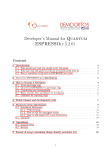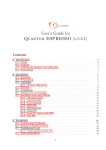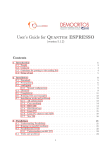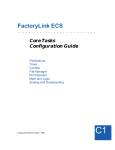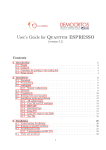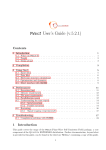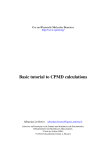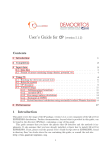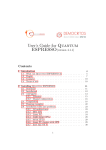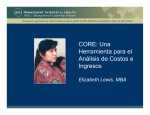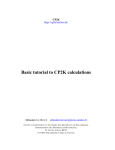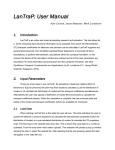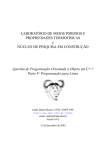Download PDF version - Quantum ESPRESSO
Transcript
Developer’s Manual for
Quantum ESPRESSO (v.5.2.1)
Contents
1 Introduction
1.1 Who should read (and who should write) this guide . . . . . . . . . . . . . . . .
1.2 Who may read this guide but will not necessarily profit from it . . . . . . . . . .
1.3 How to contribute to Quantum ESPRESSO as a user . . . . . . . . . . . . .
2
2
2
2
2 Quantum ESPRESSO as a distribution
3
3 How to become a developer
3.1 About qe-forge.org . . . . . . . . . . . . . .
3.2 Quantum ESPRESSO on qe-forge.org . .
3.3 Contributing new developments . . . . . . . .
3.4 Hints, Caveats, Do’s and Dont’s for developers
3.5 Guidelines for reporting bugs . . . . . . . . .
4
4
4
5
6
7
.
.
.
.
.
.
.
.
.
.
.
.
.
.
.
.
.
.
.
.
.
.
.
.
.
.
.
.
.
.
.
.
.
.
.
.
.
.
.
.
.
.
.
.
.
.
.
.
.
.
.
.
.
.
.
.
.
.
.
.
.
.
.
.
.
.
.
.
.
.
.
.
.
.
.
.
.
.
.
.
.
.
.
.
.
.
.
.
.
.
.
.
.
.
.
4 Stable releases and development cycle
5 Structure of the distribution
5.1 Installation Mechanism . . . . . . . . . . . . . . .
5.1.1 Preprocessing . . . . . . . . . . . . . . . .
5.1.2 How to edit the configure script . . . . .
5.1.3 How to add support for a new architecture
5.2 Libraries . . . . . . . . . . . . . . . . . . . . . . .
7
.
.
.
.
.
.
.
.
.
.
.
.
.
.
.
.
.
.
.
.
.
.
.
.
.
.
.
.
.
.
.
.
.
.
.
.
.
.
.
.
.
.
.
.
.
.
.
.
.
.
.
.
.
.
.
.
.
.
.
.
.
.
.
.
.
.
.
.
.
.
.
.
.
.
.
.
.
.
.
.
.
.
.
.
.
8
9
13
14
14
19
6 Algorithms
19
6.1 Gamma tricks . . . . . . . . . . . . . . . . . . . . . . . . . . . . . . . . . . . . . 19
6.2 Restart . . . . . . . . . . . . . . . . . . . . . . . . . . . . . . . . . . . . . . . . . 19
7 Format of arrays containing charge density, potential, etc.
20
8 Parallelization (MPI)
21
8.1 General rules . . . . . . . . . . . . . . . . . . . . . . . . . . . . . . . . . . . . . 21
8.1.1 Usage of #ifdef MPI . . . . . . . . . . . . . . . . . . . . . . . . . . . . 21
8.2 Parallelization levels and communicators . . . . . . . . . . . . . . . . . . . . . . 22
1
8.3
8.4
Tricks and pitfalls . . . . . . . . . . . . . . . . . . . . . . . . . . . . . . . . . . . 23
Data distribution . . . . . . . . . . . . . . . . . . . . . . . . . . . . . . . . . . . 23
9 File Formats
9.1 Data file(s) . . . . . . . . . . . . . . .
9.1.1 Rationale . . . . . . . . . . . .
9.1.2 General structure . . . . . . . .
9.1.3 Structure of file ”data-file.xml”
9.1.4 Sample . . . . . . . . . . . . . .
9.2 Restart files . . . . . . . . . . . . . . .
.
.
.
.
.
.
.
.
.
.
.
.
.
.
.
.
.
.
.
.
.
.
.
.
.
.
.
.
.
.
.
.
.
.
.
.
.
.
.
.
.
.
.
.
.
.
.
.
.
.
.
.
.
.
.
.
.
.
.
.
.
.
.
.
.
.
.
.
.
.
.
.
.
.
.
.
.
.
.
.
.
.
.
.
.
.
.
.
.
.
.
.
.
.
.
.
.
.
.
.
.
.
.
.
.
.
.
.
.
.
.
.
.
.
.
.
.
.
.
.
.
.
.
.
.
.
.
.
.
.
.
.
.
.
.
.
.
.
24
24
24
25
26
26
33
10 Modifying/adding/extending Quantum ESPRESSO
33
10.1 Programming style (or lack of it) . . . . . . . . . . . . . . . . . . . . . . . . . . 33
10.2 Adding or modifying input variables . . . . . . . . . . . . . . . . . . . . . . . . 34
11 Using SVN
11.1 SVN operations . . . . . . . .
11.2 Removing conflicts . . . . . .
11.3 Merging branch and trunk . .
11.4 Including a repository into the
. . . .
. . . .
. . . .
trunk
.
.
.
.
12 Bibliography
.
.
.
.
.
.
.
.
.
.
.
.
.
.
.
.
.
.
.
.
.
.
.
.
.
.
.
.
.
.
.
.
.
.
.
.
.
.
.
.
.
.
.
.
.
.
.
.
.
.
.
.
.
.
.
.
.
.
.
.
.
.
.
.
.
.
.
.
.
.
.
.
.
.
.
.
.
.
.
.
.
.
.
.
.
.
.
.
.
.
.
.
35
36
36
37
37
38
2
1
Introduction
1.1
Who should read (and who should write) this guide
The intended audience of this guide is everybody who wants to:
• know how Quantum ESPRESSO works internally;
• modify/customize/add/extend/improve/clean up Quantum ESPRESSO;
• know how to read and use data produced by Quantum ESPRESSO.
The same category of people should also write this guide, of course.
1.2
Who may read this guide but will not necessarily profit from it
People who want to know about the capabilities of Quantum ESPRESSO, or who want just
to use it, should read the User Guide instead of (or in addition to) this guide. In addition to
the general User Guide, there are also package-specific guides.
People who want to know about the methods or the physics behind Quantum ESPRESSO
should read first the relevant literature (some pointers in the User Guide).
1.3
How to contribute to Quantum ESPRESSO as a user
You can contribute to a better Quantum ESPRESSO, even as an ordinary user, by:
• Answering other people’s questions on the mailing list (correct answers are strongly preferred to wrong ones).
• Porting to new/unsupported architectures or configurations: see Sect. 5.1, ”Installation
mechanism”. You should not need to add new preprocessing flags, but if you do, see Sect.
5.1.1, ”Preprocessing”.
• Pointing out bugs in the software and in the documentation (reports of real bugs are
strongly preferred to reports of nonexistent bugs). See Sect. 3.5, ”Guidelines for reporting
bugs”.
• Improving the documentation (generic complaints or suggestions that ”there should be
this and that” do not qualify as improvements).
• Suggesting changes: note however that suggestions requiring a significant amount of
work are welcome only if accompanied by implementation or by a promise of future
implementation (fulfilled promises are strongly preferred to forgotten ones).
• Adding new features to the code. If you like to have something added to Quantum
ESPRESSO, contact the developers via the q-e-developers[.at.]qe-forge[.dot.]org
mailing list. Unless there are technical reasons not to include your changes, we will try
to make you happy (no warranty that we will actually succeed).
3
2
Quantum ESPRESSO as a distribution
Quantum ESPRESSO is not organized as a monolithic code, but rather as a distribution
(integrated suite) of “packages”, with varying degrees of integration, that can be installed on
demand, or sometimes independently. There is a “shell” structure, with at the center the core
distribution, including
• scripts, installation tools, libraries, common source files;
• basic packages
– PWscf: self-consistent calculations, structural optimization, molecular dynamics on
the ground state;
– CP: Car-Parrinello molecular dynamics;
– PostProc: data analysis and plotting (requires PWscf).
Note that some libraries are downloaded on demand from the web during the installation of the
core distribution. Then comes a first outer shell of additional packages, that can be downloaded
and installed from the core distribution using make:
• atomic: pseudopotential generation
• PHonon: Density-Functional Perturbation Theory
• NEB: reaction pathways and energy barriers
• PWCOND: ballistic conductance
• XSPECTRA: calculation of X-Ray spectra
• TDDFPT: Time-dependent DFPT (requires PHonon)
All these packages use routines from the core distribution.
A second shell of additional packages, also downloaded and installed on demand from the
core distribution, includes
• GIPAW: calculation of NMR coefficients and chemical shifts,
• EPW: electron-phonon (under development, requires PHonon).
The only difference between the ”first” and ”second” shell is that the latter are stored in
separate SVN repositories.
In a third shell of additional packages we find
• GWL: GW calculations using Lanczos chains.
This also uses routines from Quantum ESPRESSO, but it must be separately downloaded
and installed.
There is then a shell of external packages, which typically read data produced by Quantum
ESPRESSO but do not need it to work. Some of them (notably Yambo and WanT) can be
automatically downloaded and installed from the core distribution using make.
Finally there are plugins: these modify Quantum ESPRESSO packages, adding new
functionalities. The only plugin currently released is Plumed (metadynamics), but other may
come soon.
4
3
How to become a developer
If you want to get involved as a developer and contribute serious or nontrivial stuff (or even
simple and trivial stuff), you should first of all register on qe-forge.org as a developer for the
Quantum ESPRESSO project.
3.1
About qe-forge.org
qe-forge.org is the portal for Quantum ESPRESSO developers, contributors, and for anybody else wanting to develop a project in the field of atomistic simulations. qe-forge.org
provides for each project a repository, mailing lists, a wiki, upload space, a bug tracking facility, various other tools that are useful for developers.
Once you have obtained an account (please follow the instructions and introduce yourself
when you register: the site administrator has to be sure that you are a real person!) you may
open your own project, retaining all rights on it (including the right not to release anything): at
the end of the ”projects” page, click on the link ”add new project”, fill the form (note that the
Unix name given to the project cannot be modified). You have the choice between a repository
using CVS, SVN, git, plus other choices.
You may as well register as a developer in an existing project: go to the project page,
click on button ”Request to become a developer” under the ”Activity” graph on the top of the
column at the right, to obtain the permission from the administrator of the project.
You need to register your SSH keys in order to have read-write access the repository (if
you have such permissions). Generate keys on your work machine if you haven’t already, using
command ssh-keygen -t rsa. The keys are typically found in file .ssh/id-rsa.public.
Then
1. login to your qe-forge.org account
2. click on My stuff (menu on top line)
3. click on My account (menu on the left)
4. click on Edit SSH Keys, add your keys (be careful not to add blanks, breaks, etc.).
3.2
Quantum ESPRESSO on qe-forge.org
Currently Quantum ESPRESSO uses the following development tools:
• SVN server (with web interface to browse the repository)
• Bug Tracking facility
• Upload space (with download counter)
• Mailing lists, currently
– pw forum (high traffic): for ordinary users, requests for help, problems, discussions,
etc.. Only registered users can post.
– q-e-developers (low traffic): for communications among developers and people
interested in the development of Quantum ESPRESSO. Only registered users can
post but messages from unregistered users are monitored and approved if relevant.
5
– q-e-commits(medium traffic): for automatic commit messages. Note that replies to
commit messages go to the mailing list: in case of doubts or questions or remarks
over a specific commit, feel free to reply.
Everybody is encouraged to explore other capabilities of qe-forge.org.
All Quantum ESPRESSO developer are strongly invited to subscribe to the two mailing
lists q-e-developers and q-e-commits. Those who don’t lose i) the opportunity to follow
what is going on, ii) the right to complain if something has gone into a direction they don’t
like. Note that subscription to mailing lists is not automatic when you register: you should
subscribe using the links in http://www.qe-forge.org/gf/project/q-e/mailman/. Please
also consider subscribing to the bug tracker: select the ”Tracker” item on the left, then select
”Bugs”, then click on ”Start monitoring”. You will receive an e-mail every time a bug is filed.
3.3
Contributing new developments
Various procedures can be followed to contribute new developments. It is possible to contribute:
• a small (or large) piece of code to an existing package; or
• a new package that uses Quantum ESPRESSO as a library; or
• a “plugin” that modifies Quantum ESPRESSO, adding a new functionality; or
• a new “external” package that just reads data file produced by QE.
The ideal procedure depends upon the kind of project you have in mind. In all cases, you
should learn how to use SVN: see Sect.11, ”Using SVN”. The three typical cases are:
a) If your project involves changes or additions affecting only a small part of Quantum
ESPRESSO, it is usually convenient to work directly on the main SVN repository (the
”trunk”).
b) If your project involves major or extensive changes to the core of Quantum ESPRESSO,
it may be a good idea to make a SVN ”branch” and work on it. Note that your branch
will necessarily be public, since the SVN trunk is public.
c) If your project involves a major new addition (e.g. a new package), or if you do not
want it to be public during its development, it may be a good idea to register it as a
new qe-forge.org project with a separate SVN repository. It is possible to restrict
access to selected Quantum ESPRESSO developers; or to keep it private; or to have
two repositories, one public and one private. It is possible to have the public repository
automatically downloaded into the SVN copy of Quantum ESPRESSO (see Sect.11.4).
For case a), you should from time to time update your copy (using command svn update),
verify if changes made meanwhile by other developers conflict with your changes. Conflicts are
in most cases easy to solve: see Sect. 11.2 for hints on how to remove conflicts and on how to
figure out what went wrong. Once you are happy with your modified version, you can commit
your changes, or ask one of the expert developers to do this if you do not feel confident enough.
For case b), you should from time to time align your branch with the trunk. See Sect. 11.3
for hints on how to do this.
For case c): if your project is “loosely coupled” to Quantum ESPRESSO, that is, it just
uses the Quantum ESPRESSO installation procedure and/or data files, there shouldn’t be
6
any major problems, since major incompatible changes are very rare (note however that the
files produced by the phonon code change more frequently). If your project is “tightly bound”,
i.e. it uses routines from Quantum ESPRESSO, it is prudent to notify the other developers.
3.4
Hints, Caveats, Do’s and Dont’s for developers
• Before doing anything, inquire whether it is already there, or under development. In particular, check (and update) the ”Road Map” page www.quantum-espresso.org/road-map,
send a message to q-e-developers.
• Before starting writing code, inquire whether you can reuse code that is already available
in the distribution. Avoid redundancy: the only bug-free software line is the one that
doesn’t exist.
• When you make some changes:
– Check that are not spoiling other people’s work. In particular, search the distribution
for codes using the routine or module you are modifying and change its usage or its
calling arguments everywhere. Use the commit message to notify all developers if
you introduce any “dangerous” change (i.e. susceptible to break some features or
packages, including external packages using Quantum ESPRESSO).
– Do not forget that your changes must work on many different combinations of hardware and software, in both serial and parallel execution.
– Do not forget that your changes must work for a wide variety of different case: if you
implement something that works only in some selected cases, that’s ok, as long as
the code stops (or at least, issues a warning) in all other cases. There is something
worse than no results: wrong results.
– Do not forget that your changes must work on systems of wildly different computational size: a piece of code that works fine for crystal silicon may gobble a
disproportionate amount of time and/or memory in a 1000-atom cell.
• Document your contributions:
– If you modify what a code can do, or introduce incompatibilities with previous
versions (e.g. old data file no longer readable, old input no longer valid), please
report it in file Doc/release-notes.
– If you add/modify/remove input variables, document it in the appropriate INPUT *.def
file; if you remove an input variable, update tests and examples accordingly.
– All newly introduced features or variables must be accompanied by an example or a
test or both (either a new one or a modified existing test or example).
• Please do not include files (any kind, including pseudopotential files) with DOS ˆM characters or tabulators ˆI.
• When you modify the program sources, run the install/makedeps.sh script or type
make depend to update files make.depend in the various subdirectories. These files are
under SVN as well; if modified they should be committed.
7
3.5
Guidelines for reporting bugs
• Before deciding that a problem is due to a bug in the codes, verify if it is reproducible on
different machines/architectures/phases of the moon: erratic or irreproducible problems,
especially in parallel execution, are often an indication of buggy compilers or libraries
• Bug reports should preferably be filed using the bug tracking facility at qe-forge.org:
http://qe-forge.org/gf/project/q-e/tracker
• Bug reports should include enough information to be reproduced: the error message alone
is seldom a sufficient piece of information. Typically, one should report
– version number, hardware/software combination(s) for which the problem arises
– whether it happens in serial or parallel execution or both (if in parallel only, how
executed),
– an output for a test case showing the presumed bug
– all the needed info and data to re-run the test case showing the bug
The provided input should be simple and quick to execute.
• If a bug is found in a stable (released) version of Quantum ESPRESSO, it must be
reported in the Doc/release-notes file.
4
Stable releases and development cycle
Stable releases are labelled as N.M.p, where N =major, M =minor, p=bugfix. The logic goes
more or less as follows:
• Major: when something really important changes, e.g.
v.1 First public release of PWscf
v.2 Conversion from f77 to f90
v.3 Merge with the CP and FPMD codes (beginning of Quantum ESPRESSO)
v.4 New XML-based data file format
v.5 Major package and directory reorganization
(the above numbers are a slightly idealized versions of how things have gone until now)
• Minor: when some important new functionality is being added
• Bugfix: only bug fixes; occasionally, minor new functionalities that don’t break any existing ones are allowed to sneak into a bugfix release.
It may be convenient to make a SVN branch at release N.M.0: this allows to go on with the
development while keeping track of bug fixes.
Since release 5.2 (June 20, 2015), stable release are packaged at fixed dates. The initial
schedule is a release every three months.
Releases are stored to qe-forge.org. Given the size of the complete distribution, the release
is split into a “core” distribution and “add-ons”, additional packages, that can be downloaded
8
and installed on demand from the core distribution. “External” packages can be independently
released, as long as there is no compatibility problem.
The automatic downloading of packages is implemented in file install/plugins makefile
and configured in file install/plugins list. For independently released packages, it is sufficient to update links. For add-ons packages, not contained in the core distribution, there is however a catch-22: the core distribution must know the link to all packages it downloads, but these
are known only after such packages are uploaded to qe-forge.org (and the only way to discover
the exact link is to go over the released package with the mouse). The workaround is that the
core distribution looks for generic names, written in file install/plugins list. These names
are translated by qe-forge.org into specific names. After all packages have been uploaded,
file /var/lib/gforge/archives/index.php, residing on qe-forge.org, must be edited and
links updated. This requires system privileges on the machine hosting qe-forge.org.
Preparing a release When the release date approaches, development of new stuff is temporarily stopped: nothing new or potentially ”dangerous” is added, and all attention is dedicated to fix bugs and to stabilize the distribution. This manual and the user manual have to
be updated.
Edit the script dev-tools/release.sh to make tarballs.
Updating web site After the release has been uploaded to qe-forge.org, the online documentation must be copied to directory /var/www/quantum wp db/wordpress-3.1.4/wp-content/uploa
on the web site (this requires system privileges on the machine hosting the web server).
5
Structure of the distribution
Since v.5, the directory structure of Quantum ESPRESSO reflects its organization into
packages. Each package is stored into a specific subdirectory. In addition, there is a set of
directories, common to all packages, containing common code, libraries, installation utilities,
general documentation.
Common files and directories in the espresso/ directory are:
install/
include/
archive/
dev-tools/
pseudo/
Doc/
clib/
Modules/
COUPLE/
configure
make.sys
Makefile
License
README
environment_variables
flib/
upftools/
Apart from License and README whose meaning is obvious, the other files and directories are
related to
• Installation (i.e. compilation and linking):
install/, dev-tools/, archive/, configure, make.sys
• Testing (running tests and examples):
pseudo/, environment variables
9
• General documentation (not package-specific): Doc/
• C and Fortran Libraries, modules (F95): clib/, flib/, Modules/, COUPLE/ (the latter
contains code and documentation useful to call Quantum ESPRESSO programs from
external codes).
The core distribution also contains the three package-specific directories PW/, PP/, CPV/, for
PWscf, PostProc, CP, respectively. Typical subdirectory structure of a directory containing a
package (e.g. PW/):
Makefile
examples/
tests/
Doc/
src/
Note that:
• tests/ contains automated post-installation tests (only in PW/ and CPV/) while examples/
are not suitable for automated checks;
• other packages may have a slightly different structure (in particular, PHonon has three
directories for sources and none is called src/ ).
5.1
Installation Mechanism
Let us review the files related to compilation and linking:
– install/: documentation and utilities for compilation and linking
– configure: wrapper for install/configure script
– make.sys: produced by configure, contains machine-specific compilation and linking
options
– Makefile: contains dependencies and targets used by command make.
– include/: files to be included into sources, to be pre-processed.
./configure options runs install/configure, produces file make.sys. Its behavior can be
changed by modifying file install/configure.ac (see Sec.5.1.2 for more details) and running
(in install/) command autoconf. This produces a new version of install/configure.
make target checks for dependencies, recursively goes into subdirectories executing make
again. The behavior of make is thus determined by many Makefile’s in the various directories. The most important files are Makefile’s in the directories containing sources, e.g.
Modules/Makefile, PW/src/Makefile.
Dependencies of Fortran files are contained in make.depend files in each source directory.
These files must be updated if you change the sources, running script install/makedeps.sh or
using command make depend.
10
make.sys This file is produced by configure using the template in install/make.sys.in
and contains all system-specific information on
• C and Fortran compilers name, pre-processing and compilation options
• whether the Fortran compiler performs C-style preprocessing or not
• whether compiling for parallel or serial execution
• available optimized mathematical libraries, libraries to be downloaded
• Miscellanous stuff
The make.sys file is included into all Makefile’s, using the corresponding syntax. The best
documentation for the make.sys file is the file itself. Note that if you want to change something or to add more documentation into this file, you may need to modify the template file
install/make.sys.in.
Makefile The top-level Makefile contains the instructions to download, unpack, compile
and link what is required. Sample contents (comments in italic):
include make.sys
Contains machine- and Quantum ESPRESSO-specific definitions
default :
@echo ’to install, type at the shell prompt:’
...
If no target specified, ask for one, giving a list of possibilities
pw : bindir mods liblapack libblas libs libiotk libenviron
if test -d PW ; then \
( cd PW ; $(MAKE) TLDEPS= all || exit 1) ; fi
Target pw: first check the list of dependencies bindir mods ... etc., do what is needed; then
go into PW/ and give command make all. Note the use of exit 1, which is required to forward
the exit status of the sub-directory make to this makefile, since the section in parenthesis is run
in a subshell and the if / fi block will otherwise “hide” its the return status and make will
continue in case of errors.
neb : bindir mods libs pw
( cd install ; $(MAKE) -f plugins_makefile $@ || exit 1 )
Target neb: do all of the above, then go into directory install/ where make neb using plugins makefil
as Makefile will check if NEB is there, download from the network if not, compile and link it
libblas : touch-dummy
cd install ; $(MAKE) -f extlibs_makefile $@
Target libblas: this is an external library, that may or may not be needed, depending upon
what is written in make.sys. If needed, go into directory install/ where make libblas using
extlibs makefile as Makefile will check if BLAS are there, download from the network if not,
compile and build the library
11
PW/Makefile Second-level Makefile contains only targets related to a given subdirectory
or package. Sample contents:
sinclude ../make.sys
default : all
all: pw pwtools
pw:
( cd src ; $(MAKE) all || exit 1 )
pwtools: pw
( cd tools ; $(MAKE) all || exit 1 )
...
Target pw: go into src/ if it exists, and (apart from make wizardry) give command make pw.
It is important to note that pwtools has to depend on pw or else this makefile will break when
calling parallel make using make -j# Other targets are quite similar: go into a subdirectory,
e.g. Doc/ and ’make something’, e.g. make clean.
PW/src/Makefile The most important and most complex Makefile is the one in the source
directory. It is also the one you need to modify if you add something.
include ../../make.sys
Contains machine- and Quantum ESPRESSO-specific definitions
MODFLAGS= $(MOD_FLAG)../../iotk/src
$(MOD_FLAG)../../Modules $(MOD_FLAG).
Location of needed modules; MOD FLAG is defined in make.sys
PWOBJS = \
pwscf.o
Object file containing main program (this is actually redundant)
PWLIBS = \
a2fmod.o \
...
wannier_enrg.o
List of objects - add here new objects, or delete from this list. Do not forget the backslash! It
ensure continuation of the line
QEMODS=../../Modules/libqemod.a
Objects from Modules/ are available from the above archive. The directory where F95 modules
are must also be specified to the compiler!
TLDEPS=bindir mods libs liblapack libblas libenviron
TLDEPS=Top-Level DEPendencieS: a machinery to ensure proper compilation with correct
dependencies also if compiling from inside a package directory and not from top level
12
LIBOBJS = ../../flib/ptools.a ../../flib/flib.a
../../clib/clib.a
../../iotk/src/libiotk.a
All needed QE-specific libraries
all : tldeps pw.x generate_vdW_kernel_table.x
Targets that will be build - add here new executables
pw.x : $(PWOBJS) libpw.a $(LIBOBJS) $(QEMODS)
$(LD) $(LDFLAGS) -o $@ \
$(PWOBJS) libpw.a $(QEMODS) $(LIBOBJS) $(LIBS)
- ( cd ../../bin; ln -fs ../PW/src/$@ . )
Target pw.x - produces executable with the same name. It also produces a link to the executable in espresso/bin/. Do not forget tabulators even if you do not see them! All variables
(introduced by $) are either defined locally in Makefile or imported from make.sys
libpw.a : $(PWLIBS)
$(AR) $(ARFLAGS) $@ $?
$(RANLIB) $@
This builds the library libpw.a - again, do not forget tabulators
tldeps:
test -n "$(TLDEPS)" && ( cd ../.. ;
$(MAKE) $(TLDEPS) || exit 1) || :
second part of the TLDEPS machinery
clean :
- /bin/rm -f *.x *.o *.a *~ *.F90 *.d *.mod *.i *.L
There should always be a ”clean” target, removing all compiled (*.o) or preprocessed (*.F90)
stuff - compiled F95 modules may have different filenames: the four last items cover most cases
include make.depend
Contains dependencies of objects upon other objects. Sample content of file make.depend (can
be produced by install/makedep.sh):
a2fmod.o
a2fmod.o
a2fmod.o
a2fmod.o
a2fmod.o
a2fmod.o
:
:
:
:
:
:
../../Modules/io_global.o
../../Modules/ions_base.o
../../Modules/kind.o
pwcom.o
start_k.o
symm_base.o
tells us that the listed objects must have been compiled prior to compilation of a2fmod.o - make
will take care of this.
BEWARE: the Makefile system is in a stable but delicate equilibrium, resulting from many
years of experiments on many different machines. Handle with care: what works for you may
break other cases.
13
5.1.1
Preprocessing
Fortran-95 source code contains preprocessing option with the same syntax used by the C preprocessor cpp. Most F95 compilers understand preprocessing options -D ... or some similar
form. Some compilers however do not support or do not implement properly preprocessing.
In this case the preprocessing is done using cpp. Normally, configure takes care of this, by
selecting the appropriate rule @f90rule@ below, in this section of file make.sys.in:
.f90.o:
@f90rule@
and producing the appropriate file make.sys.
Preprocessing is useful to
• account for machine dependency in a unified source tree
• distinguish between parallel and serial execution when they follow different paths (i.e.
there is a substantial difference between serial execution and parallel execution on a
single processor)
• introduce experimental or special-purpose stuff
Use with care and only when needed. See file include/defs.README for a list of preprocessing
options. Please keep that list updated.
Note: include/f defs.h is obsolete and must not be used any longer.
The following capabilities of the C preprocessor are used:
• assign a value to a given expression. For instance, command #define THIS that, or the
option in the command line: -DTHIS=that, will replace all occurrences of THIS with that.
• include file (command #include)
• expand macros (command #define)
• execute conditional expressions such as
#ifdef __expression
...code A...
#else
...code B...
#endif
If expression is defined (with a #define command or from the command line with
option -D expression), then ...code A... is sent to output; otherwise ...code B...
is sent to output.
In order to make preprocessing options easy to see, preprocessing variables should start with
two underscores, as expression in the above example. Traditionally ”preprocessed” variables
are also written in uppercase.
14
5.1.2
How to edit the configure script
The configure script is generated from its source file configure.ac by the GNU autoconf
utility (http://www.gnu.org/software/autoconf/). Don’t edit configure directly: whenever it gets regenerated, your changes will be lost. Instead, go to the install/ directory,
edit configure.ac, then run autoconf to regenerate configure. If you want to keep the old
configure, make a copy first.
GNU autoconf is installed by default on most Unix/Linux systems. If you don’t have it on
your system, you’ll have to install it. You will need a recent version (e.g. v.2.65) of autoconf,
because our configure.ac file uses recent syntax.
configure.ac is a regular Bourne shell script (i.e., ”sh” – not csh!), except that:
– capitalized names starting with ”AC ” are autoconf macros. Normally you shouldn’t
have to touch them.
– square brackets are normally removed by the macro processor. If you need a square
bracket (that should be very rare), you’ll have to write two.
You may refer to the GNU autoconf Manual for more info.
make.sys.in is the source file for make.sys, that configure generates: you might want
to edit that file as well. The generation procedure is as follows: if configure.ac contains
the macro ”AC SUBST(name)”, then every occurrence of ”@name@” in the source file will be
substituted with the value of the shell variable ”name” at the point where AC SUBST was
called.
Similarly, configure.msg is generated from configure.msg.in: this file is only used by
configure to print its final report, and isn’t needed for the compilation. We did it this way
so that our configure may also be used by other projects, just by replacing the Quantum
ESPRESSO-specific configure.msg.in by your own.
configure writes a detailed log of its operation to config.log. When any configuration
step fails, you may look there for the relevant error messages. Note that it is normal for some
checks to fail.
5.1.3
How to add support for a new architecture
In order to support a previously unsupported architecture, first you have to figure out which
compilers, compilation flags, libraries etc. should be used on that architecture. In other words,
you have to write a make.sys that works: you may use the manual configuration procedure for
that (see the User Guide). Then, you have to modify configure so that it can generate that
make.sys automatically.
To do that, you have to add the case for your architecture in several places throughout
configure.ac:
1. Detect architecture
Look for these lines:
if test "$arch" = ""
then
case $host in
ia64-*-linux-gnu )
x86_64-*-linux-gnu )
*-pc-linux-gnu )
etc.
15
arch=ia64
;;
arch=x86_64 ;;
arch=ia32
;;
Here you must add an entry corresponding to your architecture and operating system.
Run config.guess to obtain the string identifying your system. For instance on a PC it
may be ”i686-pc-linux-gnu”, while on IBM SP4 ”powerpc-ibm-aix5.1.0.0”. It is convenient
to put some asterisks to account for small variations of the string for different machines
of the same family. For instance, it could be ”aix4.3” instead of ”aix5.1”, or ”athlon”
instead of ”i686”...
2. Select compilers
Look for these lines:
# candidate compilers and flags based on architecture
case $arch in
ia64 | x86_64 )
...
ia32 )
...
aix )
...
etc.
Add an entry for your value of $arch, and set there the appropriate values for several
variables, if needed (all variables are assigned some reasonable default value, defined
before the ”case” block):
- ”try f90” should contain the list of candidate Fortran 90 compilers, in order of decreasing
preference (i.e. configure will use the first it finds). If your system has parallel compilers,
you should list them in ”try mpif90”.
- ”try ar”, ”try arflags”: for these, the values ”ar” and ”ruv” should be always fine, unless
some special flag is required (e.g., -X64 With sp4).
- you should define ”try dflags” if there is any ”#ifdef” specific to your machine: for
instance, on IBM machines, ”try dflags=-D AIX” . A list of such flags can be found in
file include/defs.h.README.
You shouldn’t need to define the following: - ”try iflags” should be set to the appropriate
”-I” option(s) needed by the preprocessor or by the compiler to locate *.h files to be
included; try iflags=”-I../include” should be good for most cases
For example, here’s the entry for IBM machines running AIX:
aix )
try_mpif90="mpxlf90_r mpxlf90"
try_f90="xlf90_r xlf90 $try_f90"
try_arflags="-X64 ruv"
try_arflags_dynamic="-X64 ruv"
try_dflags="-D__AIX -D__XLF"
;;
The following step is to look for both serial and parallel fortran compilers:
16
# check serial Fortran 90 compiler...
...
AC_PROG_F77($f90)
...
# check parallel Fortran 90 compiler
...
AC_PROG_F77($mpif90)
...
echo setting F90... $f90
echo setting MPIF90... $mpif90
A few compilers require some extra work here: for instance, if the Intel Fortran compiler
was selected, you need to know which version because different versions need different
flags.
At the end of the test,
- $mpif90 is the parallel compiler, if any; if no parallel compiler is found or if --disable-parallel
was specified, $mpif90 is the serial compiler
- $f90 is the serial compiler
Next step: the choice of (serial) C and Fortran 77 compilers. Look for these lines:
# candidate C and f77 compilers good for all cases
try_cc="cc gcc"
try_f77="$f90"
case "$arch:$f90" in
*:f90 )
....
etc.
Here you have to add an entry for your architecture, and since the correct choice of C and
f77 compilers may depend on the fortran-90 compiler, you may need to specify the f90
compiler as well. Again, specify the compilers in try cc and try f77 in order of decreasing
preference. At the end of the test,
- $cc is the C compiler
- $f77 is the Fortran 77 compiler, used to compile *.f files (may coincide with $f90)
3. Specify compilation flags.
Look for these lines:
# check Fortran compiler flags
...
case "$arch:$f90" in
ia64:ifort* | x86_64:ifort* )
...
ia64:ifc* )
...
etc.
17
Add an entry for your case and define:
- ”try fflags”: flags for Fortran 77 compiler.
- ”try f90flags”: flags for Fortran 90 compiler. In most cases they will be the same as in
Fortran 77 plus some others. In that case, define them as ”$(FFLAGS) -something else”.
- ”try fflags noopt”: flags for Fortran 77 with all optimizations turned off: this is usually
”-O0”. These flags must be used for compiling flib/dlamch.f (part of our version of
Lapack): it won’t work properly with optimization.
- ”try ldflags”: flags for the linking phase (not including the list of libraries: this is decided
later).
- ”try ldflags static”: additional flags to select static compilation (i.e., don’t use shared
libraries).
- ”try dflags”: must be defined if there is in the code any #ifdef specific to your compiler
(for instance, -D INTEL for Intel compilers). Define it as ”$try dflags -D...” so that
pre-existing flags, if any, are preserved.
- if the Fortran 90 compiler is not able to invoke the C preprocessor automatically before compiling, set ”have cpp=0” (the opposite case is the default). The appropriate
compilation rules will be generated accordingly. If the compiler requires that any flags
be specified in order to invoke the preprocessor (for example, ”-fpp ” – note the space),
specify them in ”pre fdflags”.
For example, here’s the entry for ifort on Linux PC:
ia32:ifort* )
try_fflags="-O2 -tpp6 -assume byterecl"
try_f90flags="\$(FFLAGS) -nomodule"
try_fflags_noopt="-O0 -assume byterecl"
try_ldflags=""
try_ldflags_static="-static"
try_dflags="$try_dflags -D__INTEL"
pre_fdflags="-fpp "
;;
Next step: flags for the C compiler. Look for these lines:
case "$arch:$cc" in
*:icc )
...
*:pgcc )
...
etc.
Add an entry for your case and define:
- ”try cflags”: flags for C compiler.
- ”c ldflags”: flags for linking, when using the C compiler as linker. This is needed to
check for libraries written in C, such as FFTW.
- if you need a different preprocessor from the standard one ($CC -E), define it in
”try cpp”.
For example for XLC on AIX:
18
aix:mpcc* | aix:xlc* | aix:cc )
try_cflags="-q64 -O2"
c_ldflags="-q64"
;;
Finally, if you have to use a nonstandard preprocessor, look for these lines:
echo $ECHO_N "setting CPPFLAGS... $ECHO_C"
case $cpp in
cpp) try_cppflags="-P -traditional" ;;
fpp) try_cppflags="-P"
;;
...
and set ”try cppflags” as appropriate.
4. Search for libraries
To instruct configure to search for libraries, you must tell it two things: the names of
libraries it should search for, and where it should search.
The following libraries are searched for:
- BLAS or equivalent. Some vendor replacements for BLAS that are supported by Quantum ESPRESSO are:
MKL on Linux, 32- and 64-bit Intel CPUs
ACML on Linux, 64-bit AMD CPUs
essl on AIX
SCSL on sgi altix
SUNperf on sparc
Moreover, ATLAS is used over BLAS if available.
- LAPACK or equivalent. Some vendor replacements for LAPACK that are supported by
Quantum ESPRESSO are:
mkl on linux SUNperf on sparc
- FFTW (version 3) or another supported FFT library. The latter include:
essl on aix ACML on Linux, 64-bit AMD CPUs SUNperf on sparc
- the MASS vector math library on aix
- an MPI library. This is often automatically linked by the compiler
If you have another replacement for the above libraries, you’ll have to insert a new entry
in the appropriate place.
This is unfortunately a little bit too complex to explain. Basic info:
”AC SEARCH LIBS(function, name, ...)” looks for symbol ”function” in library ”libname.a”. If that is found, ”-lname” is appended to the LIBS environment variable (initially empty). The real thing is more complicated than just that because the ”-Ldirectory”
option must be added to search in a nonstandard directory, and because a given library
may require other libraries as prerequisites (for example, Lapack requires BLAS).
19
5.2
Libraries
Subdirectory flib/ contains libraries written in fortran77 (*.f) and in fortran-90 (*.f90). The
latter should not depend on any module, except for modules kinds and constants.
Subdirectory clib/ contains libraries written in C (*.c). There are currently two different
ways to ensure that fortran can call C routines. The new and recommanded way uses the
fortran-95 intrinsic iso c binding module. See Modules/wrappers.f90 for inspiration and
examples. Reference documentation can be found for instance here:
https://gcc.gnu.org/onlinedocs/gfortran/Interoperable-Subroutines-and-Functions.html
The old way uses macros in C routines:
1. F77 FUNC (func,FUNC) for function func, not containing underscore(s) in name
2. F77 FUNC (f nc,F NC) for function f nc, containing underscore(s) in name
These macros are defined in file include/c defs.h, included by all *.c files, and are automagically generated by configure. The goal of these macros is to choose the correct case
(lowercase or uppercase, the latter probably obsolete) and the correct number of underscores.
See file include/defs.h.README for more info.
6
Algorithms
6.1
Gamma tricks
In calculations using only the Γ point (k=0), the Kohn-Sham orbitals can be chosen to be
real functions in real space, so that ψ(G) = ψ ∗ (−G). This allows us to store only half of the
Fourier components. Moreover, two real FFTs can be performed as a single complex FFT. The
auxiliary complex function Φ is introduced: Φ(r) = ψj (r) + iψj+1 (r) whose Fourier transform
Φ(G) yields
∗ (−G)
∗ (−G)
, ψj+1 (G) = Φ(G)−Φ
.
ψj (G) = Φ(G)+Φ
2
2i
A side effect on parallelization is that G and −G must reside on the same processor. As
a consequence, pairs of columns with Gn01 ,n02 ,n03 and G−n01 ,−n02 ,n03 (with the exception of the case
n01 = n02 = 0), must be assigned to the same processor.
6.2
Restart
The two main packages, PWscf and CP, support restarting from interrupted calculations, Restarting is trivial in CP: it is sufficient to save from time to time a restart file containing wavefunctions,
orthogonality matrix, forces, atomic positions, at the current and previous time step.
Restarting is much more complicated in PWscf. Since v.5.1. restarting from interrupted
calculations is possible ONLY if the code has been explicitly stopped by user. It is not practical
to try to restart from any possible case, such as e.g. crashes. This would imply saving lots of
data all the time. With modern machines, this is not a good idea. Restart in PWscf currently
works as follows:
• Each loop calls check stop now just before the end. If a user request to stop is found,
create a small file restart *, containing only loop-specific local variables; close and save
files used by the loop if any; set variable conv elec to false; return
• After each routine containing a loop has been called, check if the code was either stopped
there or no convergence was achieved; if so, save data (if needed) for the current loop as
well, return.
20
• Return after return, exit all loops and go to main program, which must save needed global
variables to file. The only difference with normal exit is that temporary files are kept,
while files in portable format are not saved.
• if variable restart is set in input:
– starting potential and wavefunctions are read from file
– each routine containing a loop checks for the existence of a restart * file before
starting its loop
As of April 2013 only the electronic loop is organized ths way. Loops on nuclear positions will
be organized in the same manner once their re-organization is completed. To be done:
• wg and et should be read from data file
• rho(+paw/U/metagga info) should be written to and read from unformatted data file
similar to the file used in mix rho; portable format should be written only at convergence.
7
Format of arrays containing charge density, potential,
etc.
The index of arrays used to store functions defined on 3D meshes is actually a shorthand for
three indices, following the FORTRAN convention (”leftmost index runs faster”). An example
will explain this better. Suppose you have a 3D array psi(nr1x,nr2x,nr3x). FORTRAN
compilers store this array sequentially in the computer RAM in the following way:
psi(
1,
1,
1)
psi(
2,
1,
1)
...
psi(nr1x,
1,
1)
psi(
1,
2,
1)
psi(
2,
2,
1)
...
psi(nr1x,
2,
1)
...
...
psi(nr1x,nr2x,
1)
...
psi(nr1x,nr2x,nr3x)
etc
Let ind be the position of the (i,j,k) element in the above list: the following relation
ind = i + (j - 1) * nr1x + (k - 1) *
nr2x * nr1x
holds. This should clarify the relation between 1D and 3D indexing. In real space, the (i,j,k)
point of the FFT grid with dimensions nr1 (≤nr1x), nr2 (≤nr2x), , nr3 (≤nr3x), is
rijk =
j−1
k−1
i−1
τ1 +
τ2 +
τ3
nr1
nr2
nr3
21
where the τi are the basis vectors of the Bravais lattice. The latter are stored row-wise in the
at array: τ1 = at(:, 1), τ2 = at(:, 2), τ3 = at(:, 3).
The distinction between the dimensions of the FFT grid, (nr1,nr2,nr3) and the physical
dimensions of the array, (nr1x,nr2x,nr3x) is done only because it is computationally convenient in some cases that the two sets are not the same. In particular, it is often convenient to
have nrx1=nr1+1 to reduce memory conflicts.
8
Parallelization (MPI)
In MPI parallelization, a number of independent processes are started on as many processors,
communicating via calls to MPI libraries (the code will work even with more than one process
per processor, but this is not a smart thing to do). Each process has its own set of variables and
knows nothing about other processes’ variables. Variables that take little memory are replicated
on all processors, those that take a lot of memory (wavefunctions, G-vectors, R-space grid) are
distributed.
8.1
General rules
Calls to MPI libraries should be confined to a few selected places, not scattered everywhere into
the source code. The vast majority of parallel operations consist either in broadcasts from one
processor to all others, or in global operations: parallel sums and transpose. All you need is the
MPI communicator (plus the ID of the root processor for broadcasts), and the appropriate call to
wrapper routines, contained in espresso/Modules/mp.f90 and espresso/Modules/mp base.f90.
For instance: mp sum is a wrapper to mpi reduce, mp bcast to mpi bcast.
For efficiency reasons (latency is very significant), performing many parallel operations on
a small amount of data each must be avoided. If you can, store a sizable amount of data and
transmit it in a single MPI call. An example of REALLY BAD code:
COMPLEX, ALLOCATABLE :: wfc(:,:), swfc(:,:)
ALLOCATE (wfc(npwx,m),swfc(npwx,m))
DO i=1,m
DO j=1,m
ps = zdotc(npw,wfc(1,i),1,swfc(1,j)1)
CALL mp_sum(ps,intra_bgrp_group)
END DO
END DO
MUCH better code, both for serial and parallel speed:
COMPLEX, ALLOCATABLE :: ps(:,:), wfc(:,:), swfc(:,:)
ALLOCATE (ps(m,m), wfc(npwx,m),swfc(npwx,m))
CALL zgemm (’c’, ’n’, m, m, npw, (1.d0, 0.d0), wfc, &
npwx, swfc, npwx, (0.d0, 0.d0), ps, m)
CALL mp_sum(ps,intra_bgrp_group)
8.1.1
Usage of #ifdef
MPI
Calls to MPI libraries require variables contained into a mpif.h file that is usually absent on
serial machines. In order to prevent compilation problems on serial machines, the following
rules must be followed:
22
• Direct calls to MPI library routines must be replaced by calls to wrapper routines like
those in module mp.f90. If this is not possible or not convenient, use #ifdef MPI to
prevent compilation and usage in the serial case. Note that some compilers do not like
empty files or modules containing nothing!
• Wrapper routines do not need to be conditionally called: there are #ifdef’s inside them.
Keep the difference between serial and parallel code to a minimum: more #ifdef MPI
may be needed only when the flux of parallel and serial execution differ.
• Unneeded #ifdef MPI may be removed if already present; #ifdef
and must not be used in new developments.
8.2
PARA is obsolete
Parallelization levels and communicators
mp world.f90 is the module containing all processors on which QE is running. world comm is
the communicator between all such processors. In QE, its usage should be confined to parallel
environment initialization. It should not be used in source code, unless this is used only by
stand-alone executables that perform simple auxiliary tasks and do not allow for multiple
parallelization levels. Unless QE is started from an external code, world comm will in practice
coincides with MPI WORLD COMM.
mp image.f90 is the module containing information about “image” parallelization, i.e. division into quasi-independent similar calculations, each taking care of a different set of atomic positions (NEB, PWscf) or of different irreps/phonon wavevectors (PHonon). intra image comm
is the communicator between processors of the same image (most of the action will happen
here); inter image comm is the communicator between processors belonging to different images
(should be used only when communication between images is necessary). intra image comm
and world comm coincide if there is just one image running.
mp pools.f90 is the module containing information about k-point (“pool”) parallelization.
intra pool comm is the communicator between processors working on the same group (“pool”)
of k-points; inter pool comm is the communicator between different k-point pools. Note that:
≡ sum over local k-points + mp sum on inter pool comm
P
k
intra pool comm and intra image comm coincide if there is just one k-point pool.
mp bands.f90 is the module containing information about band parallelization. intra bgrp comm
is the communicator between processors of the same group of bands; inter band comm is the
communicator between processors belonging to different groups of bands. Note that band parallelization is currently implemented only in CP and for hybrid functionals in PW. When a
sum over all bands is needed:
P
i
≡ sum over local bands + mp sum on inter bgrp comm
intra bgrp comm and intra pool comm coincide if there is just one band group.
Plane waves (k + G or G vectors up to the specified kinetic energy cutoff) are distributed
across processors of the intra bgrp comm communicators. Sums over all plane waves or Gvectors (as e.g. in scalar products hφi |φj i) should be performed as follows:
P
G
≡ mp sum on intra bgrp comm
The same holds for real-space FFT’s grid.
23
8.3
Tricks and pitfalls
• Replicated calculations may either be performed independently on each processor, or
performed on one processor and broadcast to all others. The first approach requires less
programming, but it is unsafe: in principle all processors should yield exactly the same
results, if they work on the same data, but sometimes they don’t (depending on the
machine, compiler, and libraries). Even a tiny difference in the last significant digit can
eventually cause serious trouble if allowed to build up, especially when a replicated check
is performed (in which case the code may ”hang” if the check yields different results on
different processors). Never assume that the value of a variable produced by replicated
calculations is exactly the same on all processors: when in doubt, broadcast the value
calculated on a specific processor (the ”root” processor) to all others.
• Routine errore should be called in parallel by all processors, or else it will hang
• I/O operations: file opening, closing, and so on, are as a rule performed only on processor
ionode. The correct way to check for errors is the following:
IF ( ionode ) THEN
OPEN ( ..., IOSTAT=ierr )
...
END IF
CALL mp_bcast( ierr, ... , intra_image_comm )
CALL errore( ’routine’,’error’, ierr )
The same applies to all operations performed on a single processor, or a subgroup of
processors: any error code must be broadcast before the check.
8.4
Data distribution
Quantum ESPRESSO employ arrays whose memory requirements fall into three categories.
• Fully Scalable: Arrays that are distributed across processors of a pool. Fully scalable
arrays are typically large to very large and contain one of the following dimensions:
– number of plane waves, npw (or max number, npwx)
– number of Gvectors, ngm
– number of grid points in the R space, dfft%nnr
Their size decreases linearly with the number of processors in a pool.
• Partially Scalable: Arrays that are distributed across processors of the ortho or diag group.
Typically they are much smaller than fully scalable array, and small in absolute terms
for moderate-size system. Their size however increases quadratically with the number
of atoms in the system, so they have to be distributed for large systems (hundreds to
thousands atoms). Partially scalable arrays contain none of the dimensions listed above,
two of the following dimensions:
– number of states, nbnd
– number of atomic states, natomwfc
– number of projectors, nkb
24
Their size decreases linearly with the number of processors in a ortho or diag group.
• Nonscalable: All the remaining arrays, that are not distributed across processors. These
are typically small arrays, having dimensions like for instance:
– number of atoms, nat
– number of species of atoms, nsp
The size of these arrays is independent on the number of processors.
9
File Formats
9.1
Data file(s)
Quantum ESPRESSO restart file specifications: Paolo Giannozzi scripsit AD 2005-11-11,
Last modified by Andrea Ferretti 2006-10-29
9.1.1
Rationale
Requirements: the data file should be
• efficient (quick to read and write)
• easy to read, parse and write without special libraries
• easy to understand (self-documented)
• portable across different software packages
• portable across different computer architectures
Solutions:
• use binary I/O for large records
• exploit the file system for organizing data
• use XML
• use a small specialized library (iotk) to read, parse, write
• ensure the possibility to convert to a portable formatted file
Integration with other packages:
• provide a self-standing (code-independent) library to read/write this format
• the use of this library is intended to be at high level, hiding low-level details
25
9.1.2
General structure
Format name: QEXML
Format version: 1.4.0
The ”restart file” is actually a ”restart directory”, containing several files and sub-directories.
For CP/FPMD, the restart directory is created as ”$prefix $ndw/”, where $prefix is the value
of the variable ”prefix”. $ndw the value of variable ndw, both read in input; it is read from
”$prefix $ndr/”, where $ndr the value of variable ndr, read from input. For PWscf, both input
and output directories are called ”$prefix.save/”.
The content of the restart directory is as follows:
data-file.xml
which contains:
- general information that doesn’t require large data set:
atomic structure, lattice, k-points, symmetries,
parameters of the run, ...
- pointers to other files or directories containing bulkier
data: grids, wavefunctions, charge density, potentials, ...
charge_density.dat
spin_polarization.dat
magnetization.x.dat
magnetization.y.dat
magnetization.z.dat
lambda.dat
mat_z.1
contains the charge density
contains the spin polarization (rhoup-rhodw) (LSDA case)
contain the spin polarization along x,y,z
(noncollinear calculations)
contains occupations (Car-Parrinello dynamics only)
contains occupations (ensemble-dynamics only)
<pseudopotentials>
A copy of all pseudopotential files given in input
<k-point dirs>
Subdirectories K00001/, K00002/, etc, one per k-point.
Each k-point directory contains:
evc.dat
evc1.dat
evc2.dat
gkvectors.dat
eigenval.xml
eigenval1.xml
eigenval2.xml
wavefunctions for spin-unpolarized calculations, OR
spin-up and spin-down wavefunctions, respectively,
for spin polarized (LSDA) calculations;
the details of specific k+G grid;
eigenvalues for the corresponding k-point
for spin-unpolarized calculations, OR
spin-up and spin-down eigenvalues,
for spin-polarized calculations;
in a molecular dynamics run, also wavefunctions at the preceding time step:
evcm.dat
evcm1.dat
evcm2.dat
for spin-unpolarized calculations OR
for spin polarized calculations;
• All files ”*.xml” are XML-compliant, formatted file;
• Files ”mat z.1”, ”lambda.dat” are unformatted files, containing a single record;
• All other files ”*.dat”, are XML-compliant files, but they contain an unformatted record.
26
9.1.3
Structure of file ”data-file.xml”
XML Header: whatever is needed to have a well-formed XML file
Body: introduced by <Root>, terminated by </Root>. Contains first-level tags
only. These contain only other tags, not values. XML syntax applies.
First-level tags:
second-level
data tags:
file tags:
contain either
tags, OR
tags containing data (values for a given variable), OR
tags pointing to a file
data tags syntax ( [...] = optional ) :
<TAG type="vartype" size="n" [UNIT="units"] [LEN="k"]>
values (in appropriate units) for variable corresponding to TAG:
n elements of type vartype (if character, of length k)
</TAG>
where TAG describes the variable into which data must be read;
”vartype” may be ”integer”, ”real”, ”character”, ”logical”;
if type=”logical”, LEN=k” must be used to specify the length of the variable character;
size=”n” is the dimension.
Acceptable values for ”units” depend on the specific tag.
Short syntax, used only in a few cases:
<TAG attribute="something"/> .
For instance:
<FFT_GRID nr1="NR1" nr2="NR2" nr3="NR3"/>
defines the value of the FFT grid parameters nr1, nr2, nr3 for the charge density
9.1.4
Sample
Header:
<?xml version="1.0"?>
<?iotk version="1.0.0test"?>
<?iotk file_version="1.0"?>
<?iotk binary="F"?>
These are meant to be used only by iotk (actually they aren’t)
First-level tags:
-
<HEADER>
<CONTROL>
<STATUS>
<CELL>
<IONS>
<SYMMETRIES>
<ELECTRIC_FIELD>
(global information about fmt version)
(miscellanea of internal information)
(information about the status of the CP simulation)
(lattice vector, unit cell, etc)
(type and positions of atoms in the unit cell etc)
(symmetry operations)
(details for an eventual applied electric field)
27
-
<PLANE_WAVES>
(basis set, cutoffs etc)
<SPIN>
(info on spin polarizaztion)
<MAGNETIZATION_INIT>
(info about starting or constrained magnetization)
<EXCHANGE_CORRELATION>
<OCCUPATIONS>
(occupancy of the states)
<BRILLOUIN_ZONE> (k-points etc)
<PARALLELISM>
(specialized info for parallel runs)
<CHARGE-DENSITY>
<TIMESTEPS>
(positions, velocities, nose’ thermostats)
<BAND_STRUCTURE_INFO>
(dimensions and basic data about band structure)
<EIGENVALUES>
(eigenvalues and related data)
<EIGENVECTORS>
(eigenvectors and related data)
* Tag description
<HEADER>
<FORMAT>
<CREATOR>
</HEADER>
(name and version of the format)
(name and version of the code generating the file)
<CONTROL>
<PP_CHECK_FLAG>
<LKPOINT_DIR>
<Q_REAL_SPACE>
<BETA_REAL_SPACE>
</CONTROL>
(whether
(whether
(whether
(whether
file is complete and suitable for post-processing)
kpt-data are written in sub-directories)
augmentation terms are used in real space)
projectors are used in real space, not implemented)
<STATUS> (optional, written only by CP)
<STEP>
(number $n of steps performed, i.e. we are at step $n)
<TIME>
(total simulation time)
<TITLE> (a job descriptor)
<ekin>
(kinetic energy)
<eht>
(hartree energy)
<esr>
(Ewald term, real-space contribution)
<eself> (self-interaction of the Gaussians)
<epseu> (pseudopotential energy, local)
<enl>
(pseudopotential energy, nonlocal)
<exc>
(exchange-correlation energy)
<vave>
(average of the potential)
<enthal> (enthalpy: E+PV)
</STATUS>
<CELL>
<NON-PERIODIC_CELL_CORRECTION>
<BRAVAIS_LATTICE>
<LATTICE_PARAMETER>
<CELL_DIMENSIONS> (cell parameters)
<DIRECT_LATTICE_VECTORS>
28
<UNITS_FOR_DIRECT_LATTICE_VECTORS>
<a1>
<a2>
<a3>
<RECIPROCAL_LATTICE_VECTORS>
<UNITS_FOR_RECIPROCAL_LATTICE_VECTORS>
<b1>
<b2>
<b3>
</CELL>
<MOVING_CELL> (optional, PW only)
<CELL_FACTOR>
<IONS>
<NUMBER_OF_ATOMS>
<NUMBER_OF_SPECIES>
<UNITS_FOR_ATOMIC_MASSES>
For each $n-th species $X:
<SPECIE.$n>
<ATOM_TYPE>
<MASS>
<PSEUDO>
</SPECIE.$n>
<PSEUDO_DIR>
<UNITS_FOR_ATOMIC_POSITIONS>
For each atom $n of species $X:
<ATOM.$n SPECIES="$X" INDEX=nt tau=(x,y,z) if_pos=...>
</IONS>
<SYMMETRIES> (optional, PW only)
<NUMBER_OF_SYMMETRIES>
<NUMBER_OF_BRAVAIS_SYMMETRIES>
<INVERSION_SYMMETRY>
<DO_NOT_USE_TIME_REVERSAL>
<TIME_REVERSAL_FLAG>
<NO_TIME_REV_OPERATIONS>
<NUMBER_OF_ATOMS>
<UNITS_FOR_SYMMETRIES>
For each symmetry $n:
<SYMM.$n>
<INFO>
<ROTATION>
<FRACTIONAL_TRANSLATION>
<EQUIVALENT_IONS>
</SYMM.$n>
For the remaining bravais symmetries:
<SYMM.$n>
<INFO>
29
<ROTATION>
</SYMM.n>
</SYMMETRIES>
<ELECTRIC_FIELD> (optional, sawtooth field in PW only))
<HAS_ELECTRIC_FIELD>
<HAS_DIPOLE_CORRECTION>
<FIELD_DIRECTION>
<MAXIMUM_POSITION>
<INVERSE_REGION>
<FIELD_AMPLITUDE>
</ELECTRIC_FIELD>
<PLANE_WAVES>
<UNITS_FOR_CUTOFF>
<WFC_CUTOFF>
<RHO_CUTOFF>
<MAX_NUMBER_OF_GK-VECTORS>
<GAMMA_ONLY>
<FFT_GRID>
<GVECT_NUMBER>
<SMOOTH_FFT_GRID>
<SMOOTH_GVECT_NUMBER>
<G-VECTORS_FILE>
link to file "gvectors.dat"
<SMALLBOX_FFT_GRID>
</PLANE_WAVES>
<SPIN>
<LSDA>
<NON-COLINEAR_CALCULATION>
<SPIN-ORBIT_CALCULATION>
<SPINOR_DIM>
<SPIN-ORBIT_DOMAG>
</SPIN>
<MAGNETIZATION_INIT>
<CONSTRAINT_MAG>
<NUMBER_OF_SPECIES>
For each species X:
<SPECIE.$n>
<STARTING_MAGNETIZATION>
<ANGLE1>
<ANGLE2>
<CONSTRAINT_1,2,3>
</SPECIE.$n>
<FIXED_MAGNETIZATION_1,2,3>
<MAGNETIC_FIELD_1,2,3>
<TWO_FERMI_ENERGIES>
<UNITS_FOR_ENERGIES>
30
<FIXED_MAGNETIZATION>
<ELECTRONS_UP>
<ELECTRONS_DOWN>
<FERMI_ENERGY_UP>
<FERMI_ENERGY_DOWN>
<LAMBDA>
</MAGNETIZATION_INIT>
<EXCHANGE_CORRELATION>
<DFT>
<LDA_PLUS_U_CALCULATION>
if LDA_PLUS_U_CALCULATION
<NUMBER_OF_SPECIES>
<HUBBARD_LMAX>
<HUBBARD_L>
<HUBBARD_U>
<LDA_PLUS_U_KIND>
<U_PROJECTION_TYPE>
<HUBBARD_J>
<HUBBARD_J0>
<HUBBARD_ALPHA>
<HUBBARD_BETA>
endif
if <NON_LOCAL_DF>
<VDW_KERNEL_NAME>
if <DFT_D2>
<SCALING_FACTOR>
<CUTOFF_RADIUS>
if <XDM>
if <TKATCHENKO-SCHEFFLER>
<ISOLATED_SYSTEM>
</EXCHANGE_CORRELATION>
if hybrid functional
<EXACT_EXCHANGE>
<x_gamma_extrapolation>
<nqx1>
<nqx2>
<nqx3>
<exxdiv_treatment>
<yukawa>
<ecutvcut>
<exx_fraction>
<screening_parameter>
</EXACT_EXCHANGE>
endif
<OCCUPATIONS>
<SMEARING_METHOD>
31
if gaussian smearing
<SMEARING_TYPE>
<SMEARING_PARAMETER>
endif
<TETRAHEDRON_METHOD>
if use tetrahedra
<NUMBER_OF_TETRAHEDRA>
for each tetrahedron $t
<TETRAHEDRON.$t>
endif
<FIXED_OCCUPATIONS>
if using fixed occupations
<INFO>
<INPUT_OCC_UP>
if lsda
<INPUT_OCC_DOWN>
endif
endif
</OCCUPATIONS>
<BRILLOUIN_ZONE>
<NUMBER_OF_K-POINTS>
<UNITS_FOR_K-POINTS>
<MONKHORST_PACK_GRID>
<MONKHORST_PACK_OFFSET>
For each k-point $n:
<K-POINT.$n>
<STARTING_F_POINTS>
For each starting k-point $n:
<K-POINT_START.$n> kx, ky, kz, wk
<NORM-OF-Q>
</BRILLOUIN_ZONE>
<PARALLELISM>
<GRANULARITY_OF_K-POINTS_DISTRIBUTION>
<NUMBER_OF_PROCESSORS>
<NUMBER_OF_PROCESSORS_PER_POOL>
<NUMBER_OF_PROCESSORS_PER_IMAGE>
<NUMBER_OF_PROCESSORS_PER_TASKGROUP>
<NUMBER_OF_PROCESSORS_PER_POT>
<NUMBER_OF_PROCESSORS_PER_BAND_GROUP>
<NUMBER_OF_PROCESSORS_PER_DIAGONALIZATION>
</PARALLELISM>
<CHARGE-DENSITY>
link to file "charge_density.rho"
</CHARGE-DENSITY>
<TIMESTEPS>
(optional)
32
For each time step $n=0,M
<STEP$n>
<ACCUMULATORS>
<IONS_POSITIONS>
<stau>
<svel>
<taui>
<cdmi>
<force>
<IONS_NOSE>
<nhpcl>
<nhpdim>
<xnhp>
<vnhp>
<ekincm>
<ELECTRONS_NOSE>
<xnhe>
<vnhe>
<CELL_PARAMETERS>
<ht>
<htve>
<gvel>
<CELL_NOSE>
<xnhh>
<vnhh>
</CELL_NOSE>
</TIMESTEPS>
<BAND_STRUCTURE_INFO>
<NUMBER_OF_BANDS>
<NUMBER_OF_K-POINTS>
<NUMBER_OF_SPIN_COMPONENTS>
<NON-COLINEAR_CALCULATION>
<NUMBER_OF_ATOMIC_WFC>
<NUMBER_OF_ELECTRONS>
<UNITS_FOR_K-POINTS>
<UNITS_FOR_ENERGIES>
<FERMI_ENERGY>
</BAND_STRUCTURE_INFO>
<EIGENVALUES>
For all kpoint $n:
<K-POINT.$n>
<K-POINT_COORDS>
<WEIGHT>
<DATAFILE>
</K-POINT.$n>
</EIGENVALUES>
link to file "./K$n/eigenval.xml"
33
<EIGENVECTORS>
<MAX_NUMBER_OF_GK-VECTORS>
For all kpoint $n:
<K-POINT.$n>
<NUMBER_OF_GK-VECTORS>
<GK-VECTORS>
for all spin $s
<WFC.$s>
<WFCM.$s>
link to file "./K$n/gkvectors.dat"
link to file "./K$n/evc.dat"
link to file "./K$n/evcm.dat" (optional)
containing wavefunctions at preceding step
</K-POINT.n>
</EIGENVECTORS>
9.2
Restart files
10
Modifying/adding/extending Quantum ESPRESSO
10.1
Programming style (or lack of it)
There are currently no strict guidelines for developers. You should however follow at least the
following loose ones:
• Preprocessing options should be capitalized and start with two underscores. Examples:
AIX, LINUX, ...
• Fortran commands should be capitalized: CALL something( )
• Variable names should be lowercase: foo = bar/2
• Indent DO’s and IF’s with three white spaces (editors like emacs will do this automatically
for you)
• Do not write crammed code: leave spaces, insert empty separation lines
• Use comments (introduced by a !) to explain what is not obvious from the code. Remember that what is obvious to you may not be obvious to other people. It is especially
important to document what a routine does, what it needs on input, what it produces on
output. A few words of comment may save hours of searching into the code for a piece
of missing information.
• do not use machine-dependent extensions or sloppy syntax. An example: Standard f90
requires that a & is needed both at end of line AND at the beginning of continuation line
if there is a character variable (inside ’ ’ or ” ”) spanning two lines. Some compilers do
not complain if the latter & is missing, others do.
• use ”dp” (defined in module ”kinds”) to define the type of real and complex variables
• all constants should be defined to be of kind ”dp”. Preferred syntax: 0.0 dp.
• use ”generic” intrinsic functions: SIN, COS, etc.
34
• conversions should be explicitely indicated. For conversions to real, use DBLE, or else
REAL(...,KIND=dp). For conversions to complex, use CMPLX(...,...,KIND=dp). For
complex conjugate, use CONJG. For imaginary part, use AIMAG. IMPORTANT: Do
not use REAL or CMPLX without KIND=dp, or else you will lose precision (except
when you take the real part of a double precision complex number).
• Do not use automatic arrays (e.g. REAL(dp) :: A(N) with N defined at run time) unless
you are sure that the array is small in all cases: large arrays may easily exceed the stack
size, or the memory size,
• Do not use pointers unless you have a good reason to: pointers may hinder optimization.
Allocatable arrays should be used instead.
• If you use pointers, nullify them before performing tests on their status.
• Beware fancy constructs like structures: they look great on paper, but they also have
the potential to make a code unreadable, or inefficient, or simply unusable because some
compiler gets confused. Avoid nested structures unless you have a valid reason to use
them.
• Be careful with F90 array syntax and in particular with array sections. Passing an array
section to a routine may look elegant but it may turn out to be inefficient: a copy will
be silently done if the section is not contiguous in memory (or if the compiler decides it
is the right thing to do), increasing the memory footprint.
• Do not pass unallocated arrays as arguments, even in those cases where they are not
actually used inside the subroutine: some compilers don’t like it.
• Do not use any construct that is susceptible to be flagged as out-of-bounds error, even if
no actual out-of-bound error takes place.
• Always use IMPLICIT NONE and declare all local variables. All variables passed as
arguments to a routine should be declared as INTENT (IN), (OUT), or (INOUT). All
variables from modules should be explicitly specified via USE module, ONLY : variable.
Variables used in an array declaration must be declared first, as in the following example:
INTEGER, INTENT(IN)
:: N
REAL(dp), INTENT(OUT) :: A(N)
in this order (some compilers complain if you put the second line before the first).
10.2
Adding or modifying input variables
New input variables should be added to ”Modules/input parameters.f90”, then copied to the
code internal variables in the ”input.f90” subroutine. The namelists and cards parsers are
in ”Modules/read namelists.f90” and ”Modules/read cards.f90”. Files ”input parameters.f90”,
”read namelists.f90”, ”read cards.f90” are shared by all codes, while each code has its own
version of ”input.f90” used to copy input values into internal variables
EXAMPLE: suppose you need to add a new input variable called ”pippo” to the namelist
control, then:
1. add pippo to the input parameters.f90 file containing the namelist control
35
INTEGER :: pippo = 0
NAMELIST / control / ....., pippo
Remember: always set an initial value!
2. add pippo to the control default subroutine (contained in module read namelists.f90 )
subroutine control_default( prog )
...
IF( prog == ’PW’ ) pippo = 10
...
end subroutine
This routine sets the default value for pippo (can be different in different codes)
3. add pippo to the control bcast subroutine (contained in module read namelists.f90 )
subroutine control_bcast( )
...
call mp_bcast( pippo, intra_image_comm )
...
end subroutine
11
Using SVN
Quantum ESPRESSOis maintained in a Subversion (SVN) repository. Developers can have
read-write access when needed. Note that the latest (development) version may not work
properly, and sometimes not even compile properly. Use at your own risk.
Subversion, also known as SVN, is a software that allows many developers to work and
maintain a single copy of a software in a central location (repository). It is installed by default
on many Unix machines, or otherwise it can be very easily installed. For the end user, SVN
is rather similar to CVS: if no advanced features are used, the basic commands are the same.
More information on SVN can be found here: http://subversion.apache.org/.
Current organization:
• trunk: development goes on here – open read-only to everybody
• branches: major new developments, disruptive changes, very experimental features, things
that have a long time before being released (if ever) ... – branches may or may not be
public
• external: packages that are be developed in a separate SVN trunk can be downloaded
into the main QE trunk – access may be restricted to specific (usually expert) developers.
Follow the instructions in http://qe-forge.org/gf/project/q-e/scmsvn, under ‘Access
Info”, to check out (i.e. download) the SVN repository in either read-write or anonymous mode.
The distribution will appear in directory trunk/espresso/. Branches (i.e. sub-versions) will
appear as separate directories.
36
11.1
SVN operations
To update the code to the current version:
svn update
in the directory containing the distribution. To see the difference between the current version
and your modified copy:
svn diff
To save your modified version into the repository: (read-write access only):
svn commit
Please explain in a few words what your commit is about! Use option -m"comment" or the
editor of your choice (set it using the SVN EDITOR environment variable). If you want to add a
new file, or a new directory, before commiting give command
svn add
To remove a file/directory (if empty):
svn delete
You can move a file (a directory, a group of files, ...) into a different directory using command
svn mv
11.2
Removing conflicts
When you update your working copy of the repository, you may encounter two types of conflicts:
1. Somebody else has changed the same lines that you have modified.
2. Somebody else has changed something that has broken one or more functionalities of your
modified version.
Here we are concerned with kind 1. of conflicts, those that are noticed by SVN and produce,
in addition to a message with a ”C” in the first column before the conflicting file name:
• conflicting-file containing an attempted merge of your version with the SVN version,
with conflicting sections indicated by
<<<<<<<
(your version)
=======
(SVN version)
>>>>>>>
• conflicting-file.mine containing your version
• two conflicting-file.rXXXXX containing the two most recent versions (XXXXX is the
revision number) in SVN.
37
Look into the conflicting section(s): in most cases, conflicts are trivial (format changes, white
spaces) or easily solved (the part of the code you were modifying has been moved to another
place, or a variable has meanwhilke changed name, for instance). Edit conflicting-file,
remove all other copies of conflicting-file.*, commit.
Sometimes, the conflict is not so easy to solve. In this case, you can selectively update your
repository at a given date, or at a given revision number, using command (XXXXX=revision
number)
svn update -r XXXXX
You can also select a date, using {”date”} instead of the revision number. In this way you can
locate which change(s) is (are) the culprit(s). The web-SVN interface:
http://qe-forge.org/gf/project/q-e/scmsvn
will also be very helpful in locating the problem. Of course, communication with other developers will also help. The above paragraph applies as well to case 2. os conflicts, in presence or
in absence of explicit SVN conflicts. If the reason for malfunctioning is not evident, you have
to figure out when the problem started. Once this is done, itis usually straightforward to figure
out why.
11.3
Merging branch and trunk
Let us assume that you have created a branch and that you are working in the directory of
your branch. The simplest way to keep it aligned with the trunk is the following command:
svn merge ^/trunk/espresso
The caret (^) syntax is a shorthand for the entire URL of the trunk. Then you have to remove
conflicts that can arise from incompatible changes made in the trunk. Then you can commit
your ”aligned” branch (beware: the commit message is very large in size if you haven’t merged
recently; if so, it may never reach the q-e-commits mailing list).
In order to merge a branch back into the trunk, the simplest procedure is to align first the
branch with the trunk and commit it, as above; then, in a clean, not locally modified, trunk:
svn merge --reintegrate ^/branches/my-espresso-branch
then, commit.
Note the following very useful property: SVN can merge anything with anything! The
following web page may be useful: http://www.math-linux.com/spip.php?article118
11.4
Including a repository into the trunk
It is possible to download other repositories into the main Quantum ESPRESSO repository.
Currently, this possibility works only for GIPAW (and EPW, which however is not aligned
to the svn version); you need to be authorized to access the GIPAW svn, though. From the
trunk/ subdirectory (the one containing espresso/), type “svn propedit svn:externals espresso”.
An editor will open. Type the name of the subdirectory of “espresso/” where you want the
repository to be downloaded, followed by the address of the repository, exit (not quit!) the
editor. Example:
GIPAW http://qeforge.qe-forge.org/svn/qe-gipaw/trunk
EPW http://qeforge.qe-forge.org/svn/epw-public/trunk/EPW
38
12
Bibliography
Fortran books:
• M. Metcalf, J. Reid, Fortran 95/2003 Explained, Oxford University Press (2004)
• S. J. Chapman, Fortran 95/2003 for Scientists and Engineers, McGraw Hill (2007)
• J. C. Adams, W. S. Brainerd, R. A. Hendrickson, R. E. Maine, J. T. Martin, B. T. Smith,
The Fortran 2003 Handbook, Springer (2009)
• W. S. Brainerd, Guide to Fortran 2003 Programming, Springer (2009)
On-line tutorials:
• Fortran: http://www.cs.mtu.edu/˜shene/COURSES/cs201/NOTES/fortran.html
• Make: http://en.wikipedia.org/wiki/Make (software)
• Configure script: http://en.wikipedia.org/wiki/Configure script
(info courtesy of Goranka Bilalbegovic)
39







































